Rete nazionale malattie rare - Istituto Superiore di SanitÃ
Rete nazionale malattie rare - Istituto Superiore di SanitÃ
Rete nazionale malattie rare - Istituto Superiore di SanitÃ
Create successful ePaper yourself
Turn your PDF publications into a flip-book with our unique Google optimized e-Paper software.
Ricerca scientifica<br />
RUOLO DEL COMPLESSO DI PROTEINE<br />
ASSOCIATE ALLA DISTROFINA<br />
NELLE DISTROFIE MUSCOLARI CONGENITE<br />
E DEI CINGOLI<br />
IN BRIEF<br />
Scientific research. Role of the dystrophin-associated glycoprotein complex in limb-girdle and congenital<br />
muscular dystrophies.<br />
Muscular dystrophies are a heterogeneous group of genetic <strong>di</strong>sorders characterized by the progressive loss of strength<br />
and integrity of the muscle tissue. Duchenne muscular dystrophy is the most frequent lethal X-linked recessive <strong>di</strong>sorder,<br />
due to mutation in the gene co<strong>di</strong>ng dystrophin. Different forms of muscular dystrophy are caused by mutations in<br />
genes co<strong>di</strong>ng components of the dystrophin associated-glycoprotein complex, the multimeric transmembrane protein<br />
complex that links the cytoskeleton to the extracellular matrix. First isolated from skeletal muscle membrane it is widely<br />
expressed in non-muscle tissues inclu<strong>di</strong>ng brain. The identification of a high number of genes, which gives rise to<br />
various forms of congenital muscular dystrophy (CMD) that <strong>di</strong>ffer in age onset, severity and muscle groups affected,<br />
has allowed a better understan<strong>di</strong>ng and has revealed the overall complexity of the pathogenesis of these <strong>di</strong>seases.<br />
A subgroup of CMD caused by defects in the glycosylation of α-dystroglycan are named dystroglycanopathies. The<br />
clinical course is wide variable and in ad<strong>di</strong>tion to muscle can compromise brain and eyes. Although the molecular<br />
mechanisms underlying the pathophysiology of CMD are still poorly understood, the advances in the field of molecular<br />
genetic, cell biology and biochemistry have opened new avenues in <strong>di</strong>agnosis and potential therapeutic strategies.<br />
Tra le <strong>malattie</strong> <strong>rare</strong> e orfane le <strong>di</strong>strofie muscolari<br />
sono un gruppo eterogeneo <strong>di</strong> <strong>malattie</strong><br />
genetiche caratterizzate dalla progressiva per<strong>di</strong>ta<br />
<strong>di</strong> forza e <strong>di</strong> integrità muscolare. L’identificazione<br />
<strong>di</strong> un elevato numero <strong>di</strong> geni responsabili <strong>di</strong> varie<br />
forme <strong>di</strong> <strong>di</strong>strofia muscolare, che <strong>di</strong>fferiscono per età<br />
d’insorgenza, severità e gruppo <strong>di</strong> muscoli colpiti, ha<br />
permesso una migliore comprensione della patologia e<br />
ne ha messo in evidenza la complessità patogenetica.<br />
La forma più comune <strong>di</strong> <strong>di</strong>strofia muscolare è la<br />
Distrofia Muscolare <strong>di</strong> Duchenne (DMD) - descritta<br />
da Duchenne nel 1861 - una forma severa, recessiva,<br />
associata al cromosoma X, che colpisce 1/3.500 bambini<br />
nati e che si manifesta nella prima decade <strong>di</strong> vita<br />
con progressiva per<strong>di</strong>ta <strong>di</strong> forza muscolare e riduzione<br />
delle abilità motorie, complicanze car<strong>di</strong>ache e respiratorie<br />
con ridotta aspettativa <strong>di</strong> vita.<br />
L’identificazione del gene alterato nella DMD e<br />
del suo prodotto proteico, la <strong>di</strong>strofina, una proteina<br />
che lega l’actina, non solo ha migliorato la <strong>di</strong>agnosi<br />
molecolare della DMD, e della sua forma meno grave,<br />
la <strong>di</strong>strofia muscolare <strong>di</strong> Becker, ma è stato un punto<br />
<strong>di</strong> svolta nella ricerca focalizzata a chiarire la patogenesi<br />
delle <strong>di</strong>strofie muscolari.<br />
Il complesso <strong>di</strong> glicoproteine associato<br />
alla <strong>di</strong>strofia (Dystrophin-associated<br />
Glycoprotein Complex, DGC)<br />
La caratterizzazione biochimica della <strong>di</strong>strofina ha<br />
portato all’isolamento <strong>di</strong> un complesso multiproteico<br />
conosciuto come Dystrophin-associated Glycoprotein<br />
Complex (DGC), che lega il citoscheletro intracellulare<br />
a proteine della matrice extracellulare (Figura).<br />
Differenti forme <strong>di</strong> <strong>di</strong>strofia muscolare, clinicamente<br />
<strong>di</strong>stinte, sono associate a mutazioni in geni che co<strong>di</strong>ficano<br />
alcuni componenti del DGC. Isolato e caratterizzato<br />
biochimicamente per la prima volta dalle membrane<br />
muscolari scheletriche, il DGC è espresso in molti tessuti<br />
non muscolari incluso polmone, rene e cervello. Le<br />
<strong>di</strong>strofie muscolari sono infatti <strong>malattie</strong> multisistemiche<br />
che, oltre a colpire la muscolatura scheletrica, car<strong>di</strong>aca e<br />
liscia, possono interessare il sistema endocrino e il sistema<br />
nervoso centrale. In alcune <strong>di</strong>strofie muscolari, come<br />
nella DMD, <strong>di</strong>fetti cognitivi e ritardo mentale sono<br />
caratteristiche spesso associate all’atrofia muscolare.<br />
I componenti del DGC, oltre alla <strong>di</strong>strofina possono<br />
essere sud<strong>di</strong>visi in tre sub-complessi: il complesso del<br />
<strong>di</strong>stroglicano, il complesso dei sorcoglicani-sarcospano<br />
10 Not Ist Super Sanità 2009;22(6 Suppl. 1):10-13


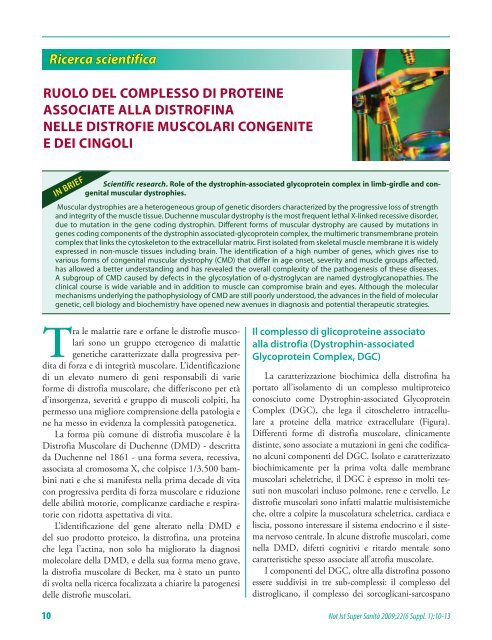
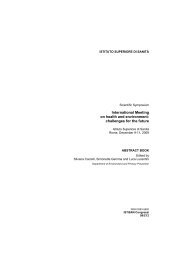
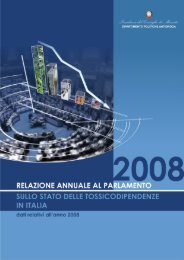
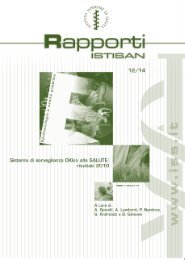

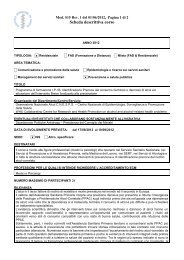
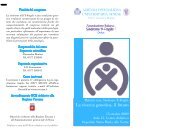
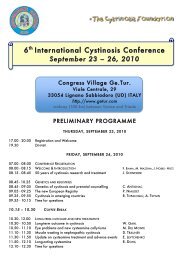
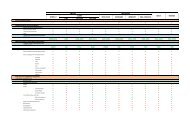
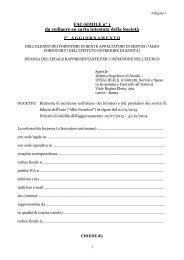
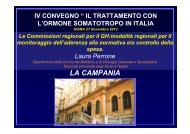
![Emilia Romagna [PDF - 175.10 kbytes]](https://img.yumpu.com/23556597/1/184x260/emilia-romagna-pdf-17510-kbytes.jpg?quality=85)
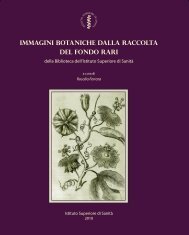
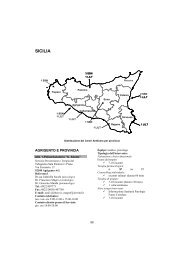
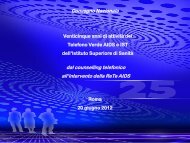
![Istisan Congressi N. 66 (Pag. 1 - 81). [PDF - 2021.12 kbytes] - Istituto ...](https://img.yumpu.com/23556493/1/171x260/istisan-congressi-n-66-pag-1-81-pdf-202112-kbytes-istituto-.jpg?quality=85)